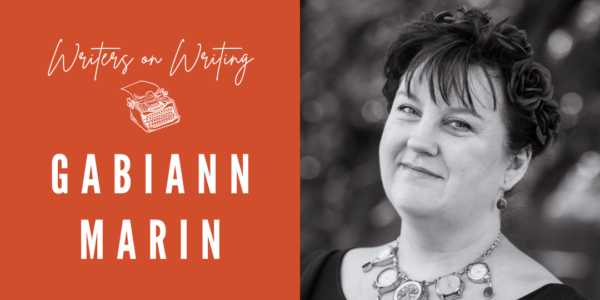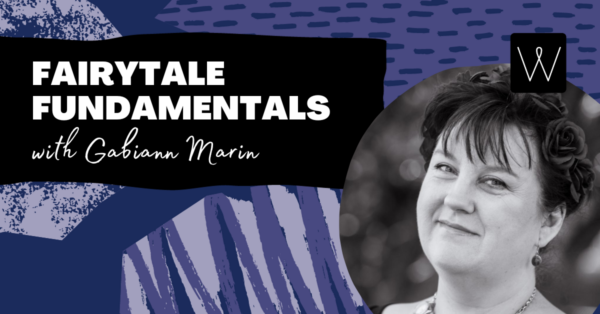
Writers on Writing is our regular conversation with a writer or industry professional about the writing craft, industry insights, and their own practice. This week, we spoke to author and story developer Gabiann Marin about fairytales and folklore as the foundations of storytelling culture, ahead of her workshop Fairytale Fundamentals on 13 April 2024.
What is it that draws you to write about mythical creatures and divine stories?
Myths are the foundations of all storytelling. They are the DNA of what we do as writers. We tend to think of them as stories that magically exist, but someone, long ago, created those stories, thought about how to structure them, how to make them exciting and engaging. From myth we see not just how we as humans interacted with the natural world, or the hierarchies of men, but how we communicated to each other. Without myth there would be no societies, no literature, no art.
When I was very young, a picture book about Greek Gods and an anthology of Aesop’s fables were my favourite books; tales of the fantastic, of monsters and animals who spoke to each other and people who took incredible journeys across vast oceans. Magic and mayhem and love and compassion. For a little girl living in an isolated country area, they opened a whole world to me, and because I was living in the bush, I immediately understood the connections they made between people and the natural world.
As an emerging writer I learnt about structure and character and how to make a story work through reading and thinking about myth. But now as a much more established writer I find that the loose narrative elements and the flexibility of mythic structures makes them so easy to incorporate into all kinds of writing, not just the fantastical.
How do you find new inspiration when talking about myths and monsters that have appeared in writing over hundreds of years?
What I realised very early on is that many of the characters I related to the most, like Medusa, Aurora, Callisto, Hera or The Ugly Duckling, were kind of trapped within their narratives. Modern writers could take mythic structures and rework them almost ad nauseum, but they still resulted in the male hero triumphing and the women being demonised, ignored or treated as a prize beloved only for their beauty and little else. So as I developed my own mythical retellings or looked at myth and fairytale in a different way, I wanted to free the female characters.
There have been a lot of mythical retellings that have focused on women being able to tell their stories – like The Penelopiad by Margaret Atwood, or Silence of the Girls by Pat Barker – but they are still telling the same story, and the characters’ tragic fates or passive acceptance were unchanged. My inspiration is to tell entirely different stories with these characters, not lock them into submissive or doomed roles.
Modern advances can also offer a wealth of new perspectives on myths: I wrote a fairytale recently all about the mythic nature of social media influencers. The internet, the world of online gaming, constructed worlds and people going on mental rather than physical journeys is a wealth of inspiration for modern fairy tale storytellers.
How do myths, fairytales and folklore play out in modern genres?
Myths are the ways that cultures tell stories of themselves and so they are designed to be adaptable and transportable in ways that more conventional ‘literature’ is not. Because they are culturally specific but narratively loose and simplistic, myths and folklore are perfect for reviving, re-telling and reworking into new modern versions of themselves that can focus on different social or cultural ideas.
We mostly think of myth, fairytale and folklore as being part of the fantasy or horror genres, or for young adults and children’s literature. But actually, it pops up virtually everywhere. Without myth there would be no modern novel, nor the short story format, as both come from mythical storytelling traditions where several small tales were woven into anthologies or larger constructed narratives. Myths, fairytales and lore aren’t seen as having an author and as such they belong to whomever hears or tells them, which again makes them incredibly useful storytelling tools – something both the Brothers Grimm and later Walt Disney realised when establishing their own writing careers.
Literary fiction has always borrowed heavily from mythical motifs and ideas, weaving them into common metaphorical writing tropes and character journeys. Think about how the early literary fiction melded history with myth in Homer’s The Odyssey which has been retold in works as different as the Sci-fi classic 2001: A Space Odyssey and James’ Joyce’s literary masterpiece Ulysses. The first recognised horror novel, Mary Shelley’s Frankenstein, took long existing folkloric stories of the undead and linked them with technological marvels of her age, and we see references to mythology and fairytale in modern detective and crime fiction, young adult books like Suzanne Collins’ The Hunger Games and of course revived mythological retellings like Circe by Madeline Miller and my own upcoming feminist comedy crime caper The Medusa Situation. It is an eternally useful set of characters, storylines, ideas, places and motifs.
Do fables, folklore and myth have their own district characteristics, or do they follow a similar structure and style?
There are some characterisation differences between myth, fable, folklore and fairytale. The common definition is that myth is a cultural story that has rites and rituals attached to it as well as formed a structural basis for a cultural set of values which were enforced and/or permeated throughout the institutions and social norms of that civilisation. Folklore and fairytale are less powerful culturally and more instructive socially or personally and are often seen as either being the basis of bigger myths or the remnants of them once they have lost their religious potency within a society. But they also each have very specific and separate storytelling, characterisation and structural traditions which help to differentiate them from each other.
What is your favourite mythical retelling?
Of course, I am going to say my retelling of the Medusa story in my book The Medusa Situation is my favourite! Because I always thought that Medusa got such a raw deal in both her origin story and in later modern retellings. I like stories that aren’t afraid to totally change up the original storyline, rather than just change the era/location or the perspective of the story from the victor to the perceived victim.
But I also love Marele Day’s book Lambs of God, which is such a strong and original retelling of myth and fairytale, borrowing so heavily on Abrahamic as well as Greek and Celtic Myth, European folklore and Australian cultural history. It is hugely underrated in my opinion. It does what I think the best mythical retelling does, it changes the story, and in that way brings myth fully into the modern era.
Gabiann Marin is an author and academic, best known for her work writing for children and her creative non-fiction books Gods and Goddesses (2018) and Monsters and Creatures (2019), which explore the true origins and historical tales of mythical creatures and divine stories. She has just published her first novel for adults, an urban mythology The Medusa Situation (2024); which is a comic retelling of the Greek myth of Medusa. When not writing she is a story developer, editor and academic, teaching narrative writing and media at universities across New South Wales.
If you want to be the first to read great advice, prompts and inspiration from our incredible tutors, subscribe to our weekly e-newsletter Newsbite.
More from Writing NSW
Check out our full range of writing courses in Sydney, our online writing courses and our feedback programs to see how we can help you on your creative writing journey. Find out about our grants and prizes, as well as writing groups across NSW, and sign up to our weekly newsletter for writing events, opportunities and giveaways.

